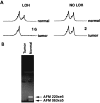ANX7, a candidate tumor suppressor gene for prostate cancer
- PMID: 11287641
- PMCID: PMC31876
- DOI: 10.1073/pnas.071055798
ANX7, a candidate tumor suppressor gene for prostate cancer
Abstract
The ANX7 gene is located on human chromosome 10q21, a site long hypothesized to harbor a tumor suppressor gene(s) (TSG) associated with prostate and other cancers. To test whether ANX7 might be a candidate TSG, we examined the ANX7-dependent suppression of human tumor cell growth, stage-specific ANX7 expression in 301 prostate specimens on a prostate tissue microarray, and loss of heterozygosity (LOH) of microsatellite markers at or near the ANX7 locus. Here we report that human tumor cell proliferation and colony formation are markedly reduced when the wild-type ANX7 gene is transfected into two prostate tumor cell lines, LNCaP and DU145. Consistently, analysis of ANX7 protein expression in human prostate tumor microarrays reveals a significantly higher rate of loss of ANX7 expression in metastatic and local recurrences of hormone refractory prostate cancer as compared with primary tumors (P = 0.0001). Using four microsatellite markers at or near the ANX7 locus, and laser capture microdissected tumor cells, 35% of the 20 primary prostate tumors show LOH. The microsatellite marker closest to the ANX7 locus showed the highest rate of LOH, including one homozygous deletion. We conclude that the ANX7 gene exhibits many biological and genetic properties expected of a TSG and may play a role in prostate cancer progression.
Figures




Similar articles
-
Haploinsufficiency of Anx7 tumor suppressor gene and consequent genomic instability promotes tumorigenesis in the Anx7(+/-) mouse.Proc Natl Acad Sci U S A. 2003 Nov 25;100(24):14287-92. doi: 10.1073/pnas.2235927100. Epub 2003 Nov 7. Proc Natl Acad Sci U S A. 2003. PMID: 14608035 Free PMC article.
-
Significant allelic loss of ANX7region (10q21) in hormone receptor negative breast carcinomas.Cancer Lett. 2004 Jul 16;210(2):239-44. doi: 10.1016/j.canlet.2004.01.018. Cancer Lett. 2004. PMID: 15183540
-
ANX7 as a bio-marker in prostate and breast cancer progression.Dis Markers. 2001;17(2):115-20. doi: 10.1155/2001/239602. Dis Markers. 2001. PMID: 11673658 Free PMC article. Review.
-
Prognostic impact of ANX7-GTPase in metastatic and HER2-negative breast cancer patients.Clin Cancer Res. 2004 Apr 1;10(7):2344-50. doi: 10.1158/1078-0432.ccr-03-0278. Clin Cancer Res. 2004. PMID: 15073110
-
Involvement of the multiple tumor suppressor genes and 12-lipoxygenase in human prostate cancer. Therapeutic implications.Adv Exp Med Biol. 1997;407:41-53. doi: 10.1007/978-1-4899-1813-0_7. Adv Exp Med Biol. 1997. PMID: 9321930 Review.
Cited by
-
Characterisation and protein expression profiling of annexins in colorectal cancer.Br J Cancer. 2008 Jan 29;98(2):426-33. doi: 10.1038/sj.bjc.6604128. Epub 2007 Dec 11. Br J Cancer. 2008. PMID: 18071363 Free PMC article.
-
ANXA9 as a novel prognostic biomarker associated with immune infiltrates in gastric cancer.PeerJ. 2021 Dec 15;9:e12605. doi: 10.7717/peerj.12605. eCollection 2021. PeerJ. 2021. PMID: 35003923 Free PMC article.
-
Targeting annexin A7 by a small molecule suppressed the activity of phosphatidylcholine-specific phospholipase C in vascular endothelial cells and inhibited atherosclerosis in apolipoprotein E⁻/⁻mice.Cell Death Dis. 2013 Sep 19;4(9):e806. doi: 10.1038/cddis.2013.317. Cell Death Dis. 2013. PMID: 24052074 Free PMC article.
-
Haploinsufficiency of Anx7 tumor suppressor gene and consequent genomic instability promotes tumorigenesis in the Anx7(+/-) mouse.Proc Natl Acad Sci U S A. 2003 Nov 25;100(24):14287-92. doi: 10.1073/pnas.2235927100. Epub 2003 Nov 7. Proc Natl Acad Sci U S A. 2003. PMID: 14608035 Free PMC article.
-
Annexin A7 is required for ESCRT III-mediated plasma membrane repair.Sci Rep. 2019 Apr 30;9(1):6726. doi: 10.1038/s41598-019-43143-4. Sci Rep. 2019. PMID: 31040365 Free PMC article.
References
-
- Creutz C E, Pazoles C J, Pollard H B. J Biol Chem. 1978;253:2858–2866. - PubMed
-
- Creutz E C, Pazoles C J, Pollard H B. J Biol Chem. 1979;254:553–558. - PubMed
-
- Raynal P, Pollard H B. Biochim Biophys Acta Biomembranes. 1994;1197:63–93. - PubMed
-
- Shirvan A, Srivastava M, Wang M A, Cultraro C, Magendzo K, McBride O W, Pollard H B, Burns A L. Biochemistry. 1994;33:6888–6901. - PubMed
Publication types
MeSH terms
Substances
LinkOut - more resources
Full Text Sources
Other Literature Sources
Medical
Miscellaneous

